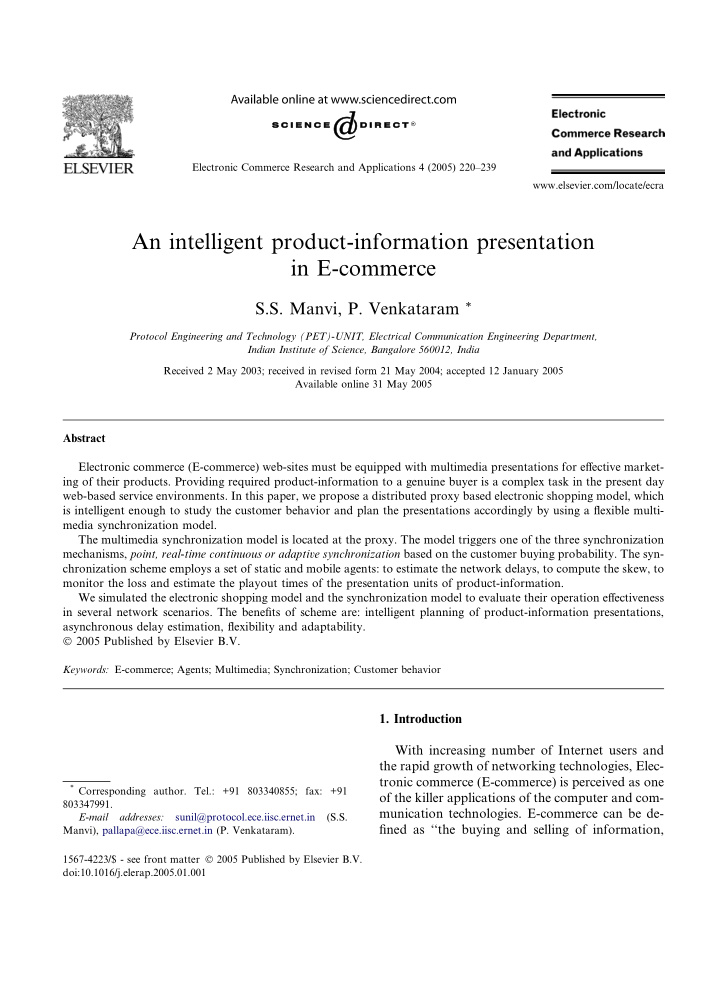



Electronic Commerce Research and Applications 4 (2005) 220–239 www.elsevier.com/locate/ecra An intelligent product-information presentation in E-commerce S.S. Manvi, P. Venkataram * Protocol Engineering and Technology (PET)-UNIT, Electrical Communication Engineering Department, Indian Institute of Science, Bangalore 560012, India Received 2 May 2003; received in revised form 21 May 2004; accepted 12 January 2005 Available online 31 May 2005 Abstract Electronic commerce (E-commerce) web-sites must be equipped with multimedia presentations for effective market- ing of their products. Providing required product-information to a genuine buyer is a complex task in the present day web-based service environments. In this paper, we propose a distributed proxy based electronic shopping model, which is intelligent enough to study the customer behavior and plan the presentations accordingly by using a flexible multi- media synchronization model. The multimedia synchronization model is located at the proxy. The model triggers one of the three synchronization mechanisms, point, real-time continuous or adaptive synchronization based on the customer buying probability. The syn- chronization scheme employs a set of static and mobile agents: to estimate the network delays, to compute the skew, to monitor the loss and estimate the playout times of the presentation units of product-information. We simulated the electronic shopping model and the synchronization model to evaluate their operation effectiveness in several network scenarios. The benefits of scheme are: intelligent planning of product-information presentations, asynchronous delay estimation, flexibility and adaptability. � 2005 Published by Elsevier B.V. Keywords: E-commerce; Agents; Multimedia; Synchronization; Customer behavior 1. Introduction With increasing number of Internet users and the rapid growth of networking technologies, Elec- tronic commerce (E-commerce) is perceived as one * Corresponding author. Tel.: +91 803340855; fax: +91 of the killer applications of the computer and com- 803347991. munication technologies. E-commerce can be de- E-mail addresses: sunil@protocol.ece.iisc.ernet.in (S.S. fined as ‘‘the buying and selling of information, Manvi), pallapa@ece.iisc.ernet.in (P. Venkataram). 1567-4223/$ - see front matter � 2005 Published by Elsevier B.V. doi:10.1016/j.elerap.2005.01.001
S.S. Manvi, P. Venkataram / Electronic Commerce Research and Applications 4 (2005) 220–239 221 products, and services via Computer networks’’. It Multimedia presentations are effective market- has changed the way that sellers distribute their ing tools that can empower any E-commerce site products and services to customers. Several ap- whether it is selling products or services. The work proaches to online shopping over a computer net- given in [15] describes about the use of 3D virtual work are: objects for entertaining and managing product cat- egories, as well as maximize profitability of prod- � Visiting a vendor site and search/browse for a uct categories. A virtual market place by using product. 3D objects representing the buyer agents, seller � Compilation of voluntary user ratings and agents, market and products is presented in [31] reviews of vendor products (Recommender that represents future trading environments. system). Multimedia stream presentations (audio, video, � Comparison-shopping for finding products and images) increase the effectiveness of product- under best terms among the vendors. information presentations which may enhance the buyer � s confidence in purchasing. We made The works given in [1–3] uses buyer mobile a survey of the E-commerce users (a sample size agents that are dispatched to vendor sites, where of 400) to get statistics of persons interested in they negotiate orders and deliveries, and returns buying over the Internet and the way they wanted to the buyer with their best deals for approval. the product-information presentation to be. It was Some of the URLs listing of agent based found that 98% of the users opted for multimedia E-commerce sites are listed in [4]. Secure agent presentations (some kind of multimedia demos to fabrication, evolution, and roaming architecture get the feeling of the product) rather than textual is proposed in [5] that manages and serves agents based presentations to zero in on the product in E-commerce. Working of recommender systems purchasing. in E-commerce and some of the related work are Multimedia presentations pose a problem of in- presented in [6]. Some of the works are based on creased downloading time, where customers are comparison-shopping agents, which query several made to wait for longer time. This problem can be sites to gather product-information and provide eliminated by using streaming medias. Streaming a virtual market place for the customers [7–9]. technology reduces the playout latency, since there The work given in [10] provides private labeled is no need to wait for complete downloading of a Voice-Over-IP calling, callback and web collabo- file: hence presentation can be started immediately ration solutions for Internet commerce. An intelli- after several parts of file are downloaded. SMIL gent shopping architecture is proposed in [11], (synchronized multimedia Internet language) is which learns user personal preferences and auton- used for multimedia presentations in E-commerce, omously shops on their behalf while protecting which performs only timeline-synchronized presen- their privacy. tations [16]. The mission of E-commerce is to help shoppers Multimedia product-information presentations zero in on a product they want to buy and deter- in E-commerce require intelligent and flexible pre- mine which vendor they want to buy it from based sentation, synchronization mechanisms to opti- on price, reputation, product availability and ser- mally utilize the network resources such as vice. Shopping web-sites should be designed in bandwidth, buffers, etc., as well as persuade the an attractive way to convert browsers into buyers: customers to purchase the products online. The it should be user friendly and easy to navigate with behavior of the customers differ from one person proper product-information presentation [12–14]. to another. Some of the users of E-commerce sites A customer should be provided with sufficient may not be genuine buyers (they may be just surf- information about the product to make buying ing the web), hence it is not required to waste the decisions especially in case of high budget products costly resources (either network or server re- such as automobiles, biomedical equipments, com- sources) for them by providing detailed multime- mercial softwares, etc. dia presentations of the product-information.
Recommend
More recommend